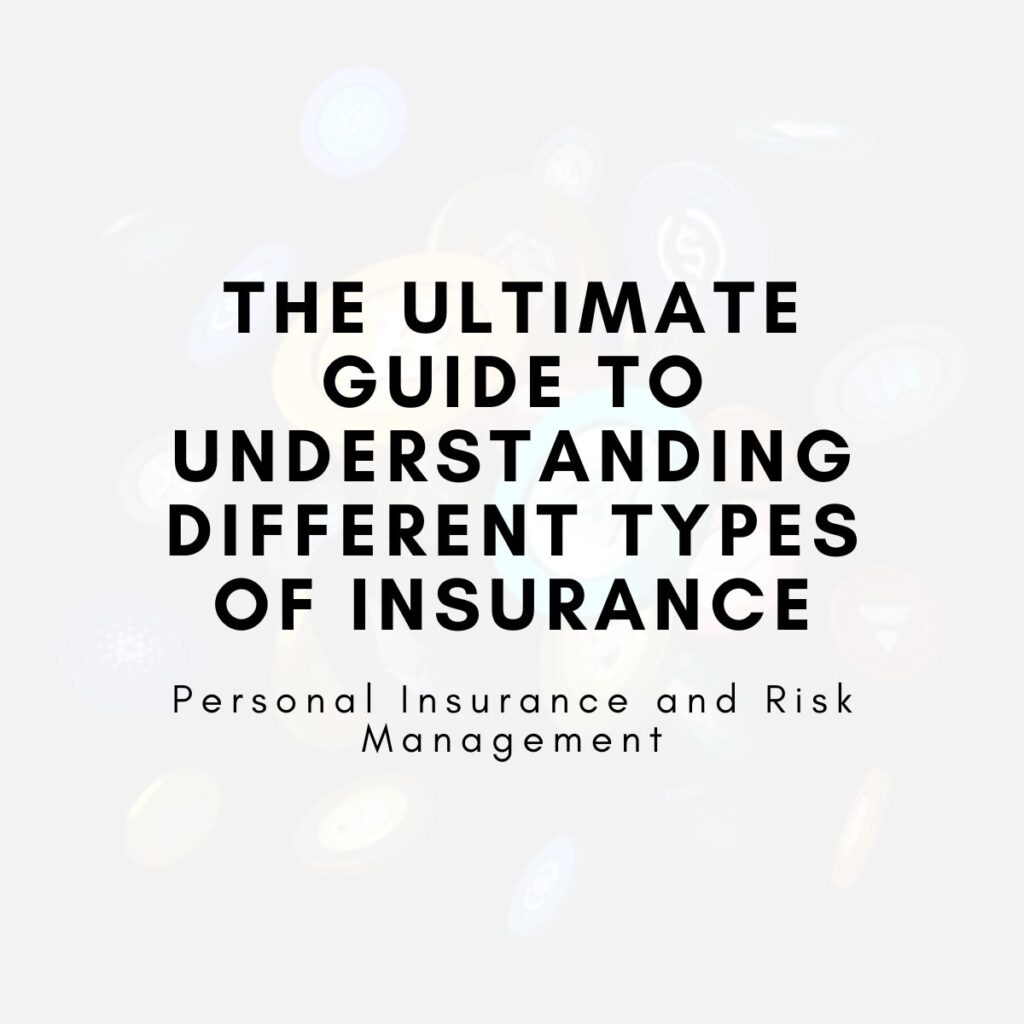
What are the different types of insurance?
Insurance is essential for protecting yourself, your family, and your assets from unexpected financial burdens. With so many types of insurance available, it can be overwhelming to know which ones you need. This comprehensive guide will break down the different types of insurance, explain their importance, and help you understand which coverage is right for your unique situation.
Table: The Ultimate Guide to Understanding Different Types of Insurance
| Section | Description | Key Tips | Examples |
|---|---|---|---|
| Health Insurance | Covers medical expenses including doctor visits, surgeries, and prescriptions. Helps reduce financial strain due to healthcare costs. | – Always compare plans for better coverage. – Consider employer-sponsored or government options. | John’s health insurance covered his broken leg treatment, saving him from high medical bills. |
| Auto Insurance | Provides financial protection in case of accidents, theft, or car damage. Legally required in most areas. | – Ensure you have liability and collision coverage. – Review your coverage after purchasing a car. | Sarah’s insurance covered the damages to her car and the other driver’s medical expenses after an accident. |
| Life Insurance | Provides a death benefit to protect your family and loved ones from financial hardship after your passing. | – Choose term life for affordability. – Consider whole life for permanent coverage. | Jane’s life insurance allowed her family to cover mortgage and education expenses after her unexpected death. |
| Homeowners Insurance | Protects your home and belongings from damage or loss due to events like fire, theft, or natural disasters. Covers liability in your home. | – Ensure adequate coverage for rebuilding. – Understand exclusions for certain disasters. | Alex’s insurance helped rebuild his kitchen after a fire, covering damages and lost possessions. |
| Renters Insurance | Covers personal belongings and liability in rented properties. Often affordable and offers financial protection for renters. | – Don’t assume your landlord’s insurance covers your property. – Choose the right coverage level. | Emily’s renters insurance covered her belongings after a fire broke out in her apartment complex. |
| Disability Insurance | Provides income replacement if you are unable to work due to illness or injury, ensuring financial stability. | – Choose long-term disability insurance if possible. – Review your employer’s disability options. | David’s disability insurance replaced a portion of his salary after he was injured on the job, helping him financially. |
| Umbrella Insurance | Offers additional liability coverage beyond the limits of your primary insurance policies. Protects your wealth in case of lawsuits. | – Consider umbrella insurance if you have significant assets. – Review liability limits. | Tom’s umbrella insurance covered costs from a visitor’s lawsuit, protecting his personal wealth from the excess costs. |
This table summarizes the key insurance types covered in the post, providing an overview of each type’s purpose, essential tips for selecting coverage, and real-life examples that highlight their importance in protecting you and your assets. Whether you’re looking to safeguard your health, car, home, or family, this guide equips you with the knowledge to make informed decisions about your insurance needs.
Introduction
Insurance is a critical aspect of personal finance that helps you protect your health, home, car, and loved ones from unexpected events. Whether you are just starting out on your financial journey or looking to make adjustments to your existing coverage, understanding the various types of insurance is essential. In this guide, we will cover the most common types of insurance, their importance, and real-life examples of how they can safeguard you in different situations. From health insurance to life insurance, auto insurance to homeowner’s insurance, knowing your options can ensure you have the protection you need for both the present and future.
1. Health Insurance
Health insurance helps cover medical expenses, including doctor visits, hospital stays, medications, and surgeries. It’s designed to reduce the financial burden of healthcare costs, ensuring you receive the medical attention you need without the worry of unaffordable bills.
Why It’s Important?
Without health insurance, medical expenses can quickly become overwhelming, especially in the event of an emergency or long-term health issue. Health insurance provides access to necessary care and helps prevent unexpected costs from derailing your financial well-being.
Real-Life Example
John, a 30-year-old self-employed individual, purchases an individual health insurance plan that costs him $300 a month. This plan covers regular doctor visits, prescriptions, and emergency room services. When John unexpectedly broke his leg while hiking, his health insurance covered a significant portion of his hospital bill, saving him from financial strain.
Types of Health Insurance
- Employer-Sponsored Health Insurance: Provided by your employer, often at discounted rates.
- Individual Health Insurance: Purchased directly from an insurance provider or through the government marketplace.
- Medicare: A federal program for individuals over 65 or those with certain disabilities.
- Medicaid: A government program for low-income individuals and families.
2. Auto Insurance
Auto insurance is designed to protect you financially in the event of a car accident, theft, or damage to your vehicle. It’s legally required in most places and ensures you are covered for both damage to your car and injury to others involved in the accident.
Why It’s Important?
Auto insurance is crucial for protecting yourself from high out-of-pocket costs if you’re involved in an accident. It also provides liability coverage in case you cause damage or injury to others, which can be financially devastating without proper insurance.
Real-Life Example
Sarah, a 28-year-old woman, drives a 5-year-old car and has basic auto insurance coverage, including liability and collision insurance. One winter, she accidentally skidded on icy roads and collided with another car. Her insurance covered the damages to her vehicle and the other driver’s medical expenses, saving her from financial ruin.
Types of Auto Insurance
- Liability Insurance: Covers the costs of injury or damage you cause to others.
- Collision Insurance: Pays for repairs to your own vehicle after an accident.
- Comprehensive Insurance: Covers damage to your car not caused by a collision (e.g., theft, fire).
- Uninsured/Underinsured Motorist Coverage: Protects you if you’re hit by someone without adequate insurance.
3. Life Insurance
Life insurance provides a financial safety net for your family and loved ones in the event of your death. It ensures that they won’t face financial hardships, such as mortgage payments, education costs, and living expenses.
Why It’s Important?
If you are the primary breadwinner or have dependents, life insurance can help maintain their financial security in your absence. It’s a powerful tool for ensuring that your family doesn’t face financial difficulties after you’re gone.
Real-Life Example
Jane, a 35-year-old mother of two, purchases a 20-year term life insurance policy with a $500,000 death benefit. Unfortunately, she passed away unexpectedly. Thanks to her life insurance, her family was able to pay off their mortgage, cover her children’s education expenses, and maintain their standard of living during a difficult time.
Types of Life Insurance
- Term Life Insurance: Covers you for a specific period and provides a death benefit if you die during that term.
- Whole Life Insurance: Provides lifetime coverage and includes a savings component.
- Universal Life Insurance: Offers flexibility in premium payments and death benefits.
- Variable Life Insurance: Combines life insurance with an investment component.
4. Homeowners Insurance
Homeowners insurance protects your home, belongings, and liability if something goes wrong, such as fire, theft, or natural disasters. It’s essential for protecting your property and ensuring that you can rebuild if the worst happens.
Why It’s Important?
Without homeowners insurance, you could be left financially devastated in the event of a natural disaster, fire, or burglary. It also helps cover personal liability if someone is injured on your property.
Real-Life Example
Alex and his family live in a suburban home. They have an HO-3 homeowners insurance policy, which covers common risks like fire, storm damage, and theft. One evening, a fire started in their kitchen, causing extensive damage. Fortunately, their homeowners insurance policy covered the cost of rebuilding their kitchen and replacing many of their lost possessions.
Types of Homeowners Insurance
- HO-1 Basic Policy: Covers specific perils such as fire or theft.
- HO-2 Broad Policy: Covers more risks than HO-1.
- HO-3 Special Policy: The most common type, covering most risks unless excluded.
- HO-5 Comprehensive Policy: Offers the most extensive coverage.
5. Renters Insurance
Renters insurance is similar to homeowners insurance but specifically for people who rent their homes. It covers personal property, liability, and sometimes additional living expenses if your rented home becomes uninhabitable.
Why It’s Important?
Renters insurance is essential even though your landlord’s insurance may cover the structure of the building. It ensures your personal belongings are protected, and you’re covered if accidents occur in your rented space.
Real-Life Example
Emily, a 23-year-old college student, rents an apartment near her university. She opted for renters insurance, which covers her electronics, clothing, and other belongings in case of fire or theft. When a fire broke out in her apartment complex, her renters insurance replaced her lost items, saving her thousands of dollars.
Types of Renters Insurance
- Personal Property Coverage: Covers loss or damage to your belongings.
- Liability Coverage: Covers injuries to others or damage to their property.
- Additional Living Expenses: Pays for temporary accommodation if your rented home is uninhabitable.
6. Disability Insurance
Disability insurance provides income replacement if you’re unable to work due to illness or injury. It ensures that you can continue to support yourself financially when you’re not able to earn an income.
Why It’s Important?
Without disability insurance, a severe injury or illness could financially ruin you, especially if you’re the sole breadwinner. This insurance allows you to focus on recovery without worrying about your finances.
Real-Life Example
David, a 45-year-old construction worker, was severely injured on the job and could no longer work. Thankfully, he had long-term disability insurance that provided him with 60% of his salary for two years, allowing him to recover without losing his home or going into debt.
Types of Disability Insurance
- Short-Term Disability Insurance: Covers a portion of your salary for a short period (up to 6 months).
- Long-Term Disability Insurance: Provides income replacement for extended periods, often until retirement.
7. Umbrella Insurance
Umbrella insurance provides extra liability coverage beyond the limits of your other insurance policies. It can help cover costs if you’re sued for something that exceeds your standard policy’s limits.
Why It’s Important?
Umbrella insurance is crucial for protecting your wealth if you’re faced with a lawsuit that exceeds the limits of your home, auto, or personal liability insurance.
Real-Life Example
Tom, a wealthy business owner, carries a personal umbrella insurance policy for an additional $1 million in coverage. When a visitor slipped and fell in his yard, their medical bills and lawsuit exceeded his homeowners insurance coverage. His umbrella insurance covered the remaining expenses, ensuring his personal assets were protected.
Conclusion
Insurance is vital for protecting yourself, your family, and your property from unexpected events. The different types of insurance—health, life, auto, homeowners, renters, and others—serve unique purposes, but each plays a crucial role in ensuring your financial stability. Regularly reviewing your insurance needs and choosing the right coverage is essential to safeguard against risks and protect your future.
Key Takeaways
- Understanding the various types of insurance ensures that you are financially protected in different aspects of life.
- Health insurance covers medical costs; auto insurance protects you from accidents; life insurance secures your family’s future; and homeowners/renters insurance protects your property.
- Disability and umbrella insurance provide extra financial security when unforeseen circumstances arise.
- Regularly review your insurance policies and adjust them as needed to ensure you maintain the right level of coverage.




